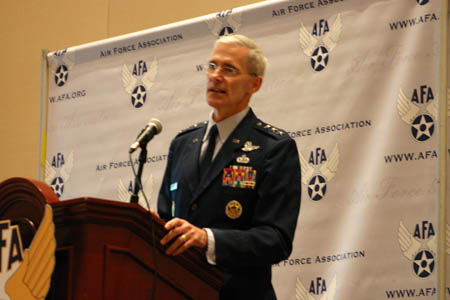 While the Air Force continues building toward 65 combat air patrols of MQ-1/MQ-9 remotely piloted aircraft—currently there are 62—the head of the service’s intelligence, surveillance, and reconnaissance enterprise believes that this force already should evolve. “We have a force that has grown up in permissive environments,” Lt. Gen. Robert Otto, the Air Staff’s ISR chief, told attendees on Tuesday at AFA’s 2013 Air and Space Conference in National Harbor, Md. While the current fleet has performed well, there has been an over-investment in “permissive ISR assets,” said Otto, who sees the need for a more balanced ISR fleet to also support operations in contested airspace. The Air Force’s forthcoming “RPA Vector” document will provide much more detail as to the service’s direction for seeking these capabilities, he said.
While the Air Force continues building toward 65 combat air patrols of MQ-1/MQ-9 remotely piloted aircraft—currently there are 62—the head of the service’s intelligence, surveillance, and reconnaissance enterprise believes that this force already should evolve. “We have a force that has grown up in permissive environments,” Lt. Gen. Robert Otto, the Air Staff’s ISR chief, told attendees on Tuesday at AFA’s 2013 Air and Space Conference in National Harbor, Md. While the current fleet has performed well, there has been an over-investment in “permissive ISR assets,” said Otto, who sees the need for a more balanced ISR fleet to also support operations in contested airspace. The Air Force’s forthcoming “RPA Vector” document will provide much more detail as to the service’s direction for seeking these capabilities, he said.
A new survey found that military and veteran spouses experience depression and anxiety at two to three times the rate of the general population, with many also reporting difficulty finding community, peer support, and suitable employment.